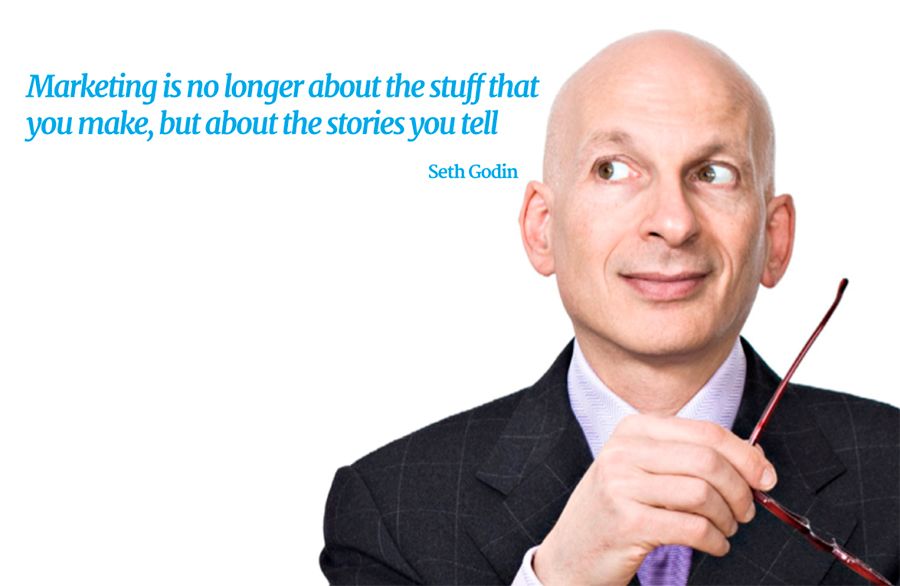Once upon a time… This is the way most stories used to begin, but now there are more ways than ever. Since we were children we have listened to many stories, passed down each generation. Nowadays, it’s not only parents who want to perpetuate their stories. Modern brands worth their salt take it upon themselves to tell their own stories to their consumers; to perpetuate their “legacy”, spark the imagination, and ultimately sell more stuff. In this ‘brand´s world’, where we have to decide between Coca-Cola and Pepsi or McDonalds and Burger King, the way stories are told is vital. Moreover, it is important not to forget that consumers can participate and interact with these stories.
As the marketing guru Seth Godin says: “people do not buy goods and services. People buy relations, stories, and magic”. This is how storytelling has made its way so easily into the marketing business. Brands have to tell consumers who they are and what they offer. They have to tell their story, but they have to tell a “tale” in a distinct way to set themselves apart.

Raquel Espantaleón, head of strategic planning of McCann Spain, affirms that “Brands have to change from the story telling to the story doing”.
What’s more, they can choose between a wealth of existing channels. In the digital era, every single day new trends on social media appear, each demonstrating new ways of storytelling.
This is how we can promote our story. Moreover, here one can find the most interesting trends that brands can use for sharing their story:
LIVE STREAMING VIDEO
 The time is NOW. Everybody knows it is not the same to watch a pre-recorded football match instead of a live one. Brands are using this idea to try to share their content instantaneously, using streaming systems. With Snapchat or Instagram stories and tools such as Facebook Live or Twitter’s Periscope brands are changing the way people connect with their stories and the user ´s brand experience. Companies can see what their brand is doing and interact with it. For example, Spotify was one of the first brands to use Periscope to show a live behind-the-scenes video of the Irish singer Conor O’Brien.
The time is NOW. Everybody knows it is not the same to watch a pre-recorded football match instead of a live one. Brands are using this idea to try to share their content instantaneously, using streaming systems. With Snapchat or Instagram stories and tools such as Facebook Live or Twitter’s Periscope brands are changing the way people connect with their stories and the user ´s brand experience. Companies can see what their brand is doing and interact with it. For example, Spotify was one of the first brands to use Periscope to show a live behind-the-scenes video of the Irish singer Conor O’Brien.
What’s more, “Spectacles”, the fashionable pair of glasses from the re-named Snap Inc. will allow people to record 30 seconds of video and post it in real time directly to the Snapchat app.
BIG DATA AND THE CLOUD
What about the quantity of stories? Firstly, people used to share their stories generation after generation in order to remember them. Later, they transcribed the stories to avoid forgetting the details. Today, that is not a problem since powerful systems have been developed in order to process and collect huge amounts of data “on the cloud”. Thanks to Big Data, it’s possible to convert data to information and make decisions in real time.
Bill Franks, chief Analytics Officer at Teradata says that, “While Big Data adds a lot of new information to the mix, the underlying value is still about the insights and actions that can be derived through the analysis of big data.”
Brands are using Big Data to learn about people’s profiles, their habits, and know how their clients feel in relation to the services that they provide.
CHATBOTS

Chatbots are robots designed to hold conversations with people without human interaction. This tool changed the way that brands speak to their target audiences and relate to them. This tool empowers the consumer, giving them more freedom to choose. Also, purchases are easier than ever thanks to ‘Conversational commerce’, an emerging way to place orders for products through these types of online conversations.
Tacobell uses “TacoBot” to order food and it is also able to answer the consumer´s questions and make recommendations with the characteristic tone of Taco Bell.
AI AND ROBOTS
Usually, people tend to prefer a story told by a person rather than a robot, but as strange as it might seem, robots can help brands to tell their stories better. For example, they can make suggestions for similar content that might interest users, the same way Netflix does when you watch a movie or the way Facebook recognizes people’s friends to help tag them in photos. The company Knorr uses cognitive technology to provide a “flavour profiler” that offers tailored recipes. Consumers can learn which recipes are best for them, based on their individual flavour profile.

SOCIAL INFLUENCERS
 In many cases, the person who tells the story is the “hook” for engagement between the company’s brands and their target audience. An influencer is a person who has credibility in relation to a specific topic and for their presence on social media. The “influencer” effect has made some brands come alive in the era of the YouTuber or become indispensable tools among the gamer demographic. PewDiePie´s is the most well-known gaming and vlogging channel on YouTube. His “Let´s play” channel (with more than 48mm subscribers) shows PewDiePie making comments and reacting to various games, while playing them and sharing his opinions with his so-called “bros”.
In many cases, the person who tells the story is the “hook” for engagement between the company’s brands and their target audience. An influencer is a person who has credibility in relation to a specific topic and for their presence on social media. The “influencer” effect has made some brands come alive in the era of the YouTuber or become indispensable tools among the gamer demographic. PewDiePie´s is the most well-known gaming and vlogging channel on YouTube. His “Let´s play” channel (with more than 48mm subscribers) shows PewDiePie making comments and reacting to various games, while playing them and sharing his opinions with his so-called “bros”.
Once new ways for brands to tell their story on social media have been presented, the next question to answer is: what should the brands say? The answers are even more diverse. Brands’ imaginations are fast becoming their only limit.


